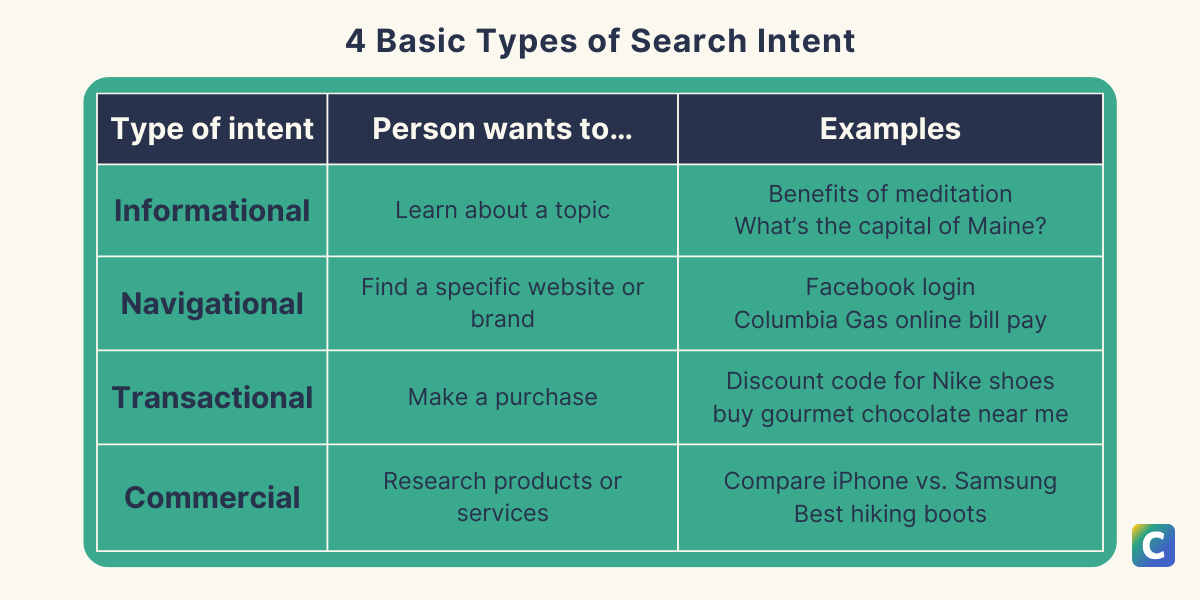Tube Rank: Your Guide to Video Success
Discover tips and insights for optimizing your video presence.
Decoding the Mystery of Search Intent
Unlock the secrets of search intent! Discover how understanding user queries can skyrocket your SEO game and boost your traffic.
Understanding the Different Types of Search Intent
Understanding search intent is crucial for creating effective SEO-focused content. Search intent refers to the underlying goal a user has when entering a query into a search engine. There are four primary types of search intent: transactional, informational, navigational, and commercial investigation. By categorizing your content according to these intents, you can tailor it to meet the specific needs of your audience, ultimately improving visibility and engagement.
1. Transactional Intent: This type of intent occurs when a user aims to make a purchase or complete a specific action. Examples include searches like 'buy running shoes' or 'subscribe to a newsletter.'
2. Informational Intent: Here, the user seeks knowledge or answers to specific questions, such as 'how to cook quinoa' or 'what is SEO?'
3. Navigational Intent: Users looking for a particular website or page demonstrate this intent, such as searching for 'Facebook login.'
4. Commercial Investigation: This intent involves users researching products or services before making a decision, often using queries like 'best smartphones in 2023.' Understanding these types allows you to align your content strategy with users’ needs more effectively.

How to Analyze and Optimize for Search Intent
Understanding search intent is crucial for optimizing your content to meet the needs of your audience. Search intent refers to the reason behind a user's query and can generally be categorized into four main types: informational, navigational, transactional, and commercial investigation. To effectively analyze search intent, start by researching keywords relevant to your niche. Utilize tools like Google Keyword Planner or SEMrush to identify what users are searching for, and categorize these keywords based on their intent. This classification will help you tailor your content to target specific queries, enhancing user satisfaction and increasing organic traffic.
Once you have identified the different types of search intents, the next step is to optimize your content accordingly. For informational intent, create comprehensive guides and articles that answer common questions. For transactional intent, ensure your product pages are rich in details and include clear calls to action. Use structured data and proper heading tags to improve SEO and make the content easily scannable. Lastly, regularly review your analytics to track the performance of your content and make necessary adjustments to better align with user intent. This ongoing process will not only boost your search rankings but also foster a loyal audience.
What is Search Intent and Why Does It Matter for SEO?
Search intent refers to the reason behind a user's query in search engines. It represents what the user is hoping to achieve when they type in specific keywords. Understanding search intent is crucial for SEO because it allows content creators and marketers to tailor their content to meet the actual needs and desires of their audience. There are generally four types of search intent: informational, navigational, transactional, and commercial investigation. Each of these intents provides valuable insight into not only what users are searching for but also how businesses can better position their content to address those needs.
When optimizing for SEO, aligning your content with the appropriate search intent can significantly improve your website's visibility and ranking in search engine results pages (SERPs). For instance, if a user is searching with the intent to buy a product, presenting them with product reviews, comparisons, and clear purchasing options will likely resonate better than general information. By focusing on search intent, websites can increase user engagement, reduce bounce rates, and ultimately boost conversion rates, making it a foundational element of a successful SEO strategy.